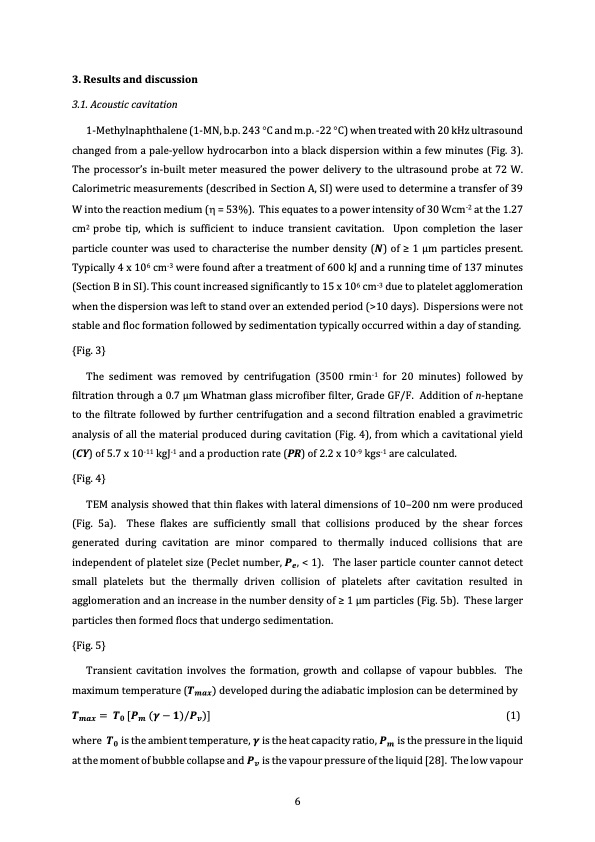
PDF Publication Title:
Text from PDF Page: 007
3. Results and discussion 3.1. Acoustic cavitation 1-Methylnaphthalene (1-MN, b.p. 243 C and m.p. -22 C) when treated with 20 kHz ultrasound changed from a pale-yellow hydrocarbon into a black dispersion within a few minutes (Fig. 3). The processor’s in-built meter measured the power delivery to the ultrasound probe at 72 W. Calorimetric measurements (described in Section A, SI) were used to determine a transfer of 39 W into the reaction medium ( = 53%). This equates to a power intensity of 30 Wcm-2 at the 1.27 cm2 probe tip, which is sufficient to induce transient cavitation. Upon completion the laser particle counter was used to characterise the number density (𝑵) of ≥ 1 μm particles present. Typically 4 x 106 cm-3 were found after a treatment of 600 kJ and a running time of 137 minutes (Section B in SI). This count increased significantly to 15 x 106 cm-3 due to platelet agglomeration when the dispersion was left to stand over an extended period (>10 days). Dispersions were not stable and floc formation followed by sedimentation typically occurred within a day of standing. {Fig. 3} The sediment was removed by centrifugation (3500 rmin-1 for 20 minutes) followed by filtration through a 0.7 μm Whatman glass microfiber filter, Grade GF/F. Addition of n-heptane to the filtrate followed by further centrifugation and a second filtration enabled a gravimetric analysis of all the material produced during cavitation (Fig. 4), from which a cavitational yield (CY) of 5.7 x 10-11 kgJ-1 and a production rate (PR) of 2.2 x 10-9 kgs-1 are calculated. {Fig. 4} TEM analysis showed that thin flakes with lateral dimensions of 10–200 nm were produced (Fig. 5a). These flakes are sufficiently small that collisions produced by the shear forces generated during cavitation are minor compared to thermally induced collisions that are independent of platelet size (Peclet number, 𝑷𝒆, < 1). The laser particle counter cannot detect small platelets but the thermally driven collision of platelets after cavitation resulted in agglomeration and an increase in the number density of ≥ 1 μm particles (Fig. 5b). These larger particles then formed flocs that undergo sedimentation. {Fig. 5} Transient cavitation involves the formation, growth and collapse of vapour bubbles. The maximum temperature (𝑻𝒎𝒂𝒙) developed during the adiabatic implosion can be determined by 𝑻𝒎𝒂𝒙 = 𝑻𝟎 [𝑷𝒎 (𝜸 − 𝟏)/𝑷𝒗)] (1) where 𝑻𝟎 is the ambient temperature, 𝜸 is the heat capacity ratio, 𝑷𝒎 is the pressure in the liquid at the moment of bubble collapse and 𝑷𝒗 is the vapour pressure of the liquid [28]. The low vapour 6PDF Image | graphene platelets with partial oxidation via cavitation

PDF Search Title:
graphene platelets with partial oxidation via cavitationOriginal File Name Searched:
Sonochemistry-Chester-Rep.pdfDIY PDF Search: Google It | Yahoo | Bing
Salgenx Redox Flow Battery Technology: Power up your energy storage game with Salgenx Salt Water Battery. With its advanced technology, the flow battery provides reliable, scalable, and sustainable energy storage for utility-scale projects. Upgrade to a Salgenx flow battery today and take control of your energy future.
| CONTACT TEL: 608-238-6001 Email: greg@infinityturbine.com | RSS | AMP |